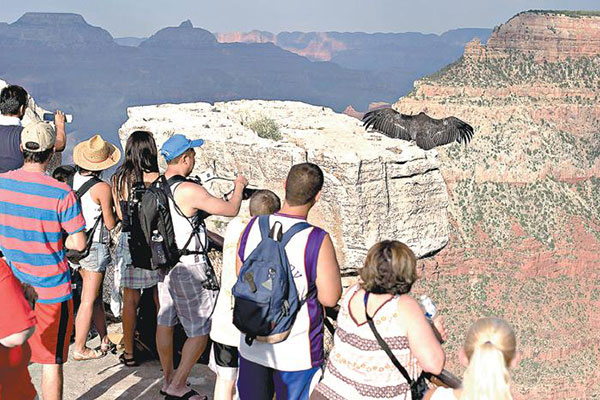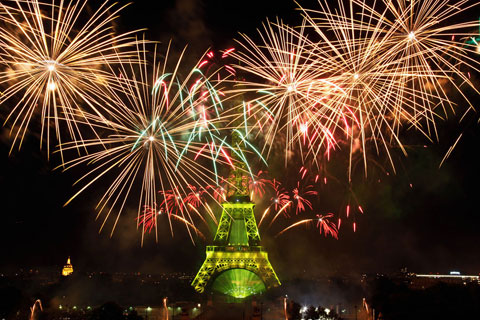Charting the history of land conservation across the US
Updated: 2015-07-16 08:57
(China Daily)
|
||||||||
 |
|
Visitors stand on an observation deck at Grand Canyon National Park in Arizona, the United States. There are 1,700 nonprofit land trusts in the US, which protect a total of 47 million acres of land-an area more than twice the size of all the national parks in the country, according to National Land Trust Census by Land Trust Alliance.[Photo/Agencies] |
Back then, the visionary landscape architect Charles Eliot published an article entitled "Waverly Oaks" to defend his stand on virgin trees in Belmont, Massachusetts, New England.
In the process of making a plea for the preservation of the oaks, Eliot outlined a strategy for conservation. Concerned by the lack of "open spaces in urban areas" for people to enjoy, he proposed a plan to safeguard "special bits of scenery".
"Just as a public library holds books and an art museum holds pictures, a nonprofit corporation should be created to hold land for the public to enjoy," he said.
His recommendation was so well-received that the Massachusetts Legislature established The Trustees of Public Reservations in 1891, with the task of acquiring and maintaining for the public beautiful and historic places.
Fast forward today, and land trusts play a crucial role in preserving vast tracks of rural areas such as pristine forests, natural water sources and wildlife habitats.
Conservation-minded landowners who donate or sell their property to land trusts enjoy state and federal tax advantages.
According to the 2010 National Land Trust Census by Land Trust Alliance, a conservation group releasing reports every five years, there are 1,700 nonprofit land trusts in the US.
These trusts protect a total of 47 million acres of land-an area more than twice the size of all the national parks in the country.
One of the most well-known conservationists in the US is media tycoon Ted Turner, founder of the Cable News Network, more popularly known as CNN.
"During the past several decades, Ted Turner has made his mark as one of the most influential philanthropists in the US," the website, tedturner.com, pointed out. "His five foundations are dedicated to securing a safer, healthier future for our planet by addressing such issues as environmental education, disease eradication, and wildlife conservation, among many others.
"Turner's foundations include the Turner Foundation, Captain Planet Foundation and the Turner Endangered Species Fund, each of which works closely with Turner Enterprises."
These organizations own more than 2 million acres of land within the US.
In 2013, The Nature Conservancy honored Turner for his lifetime commitment to conservation. "He has protected more lands through conservation easements than any other individual," the foundation said.
Data released by The Nature Conservancy shows that Turner's enterprises protect 150,000 acres of land from Georgia in the south of the US to Montana in the west. This involves conserving water resources, critical habitat and endangered species.
Roxanne Quimby, co-founder of the cosmetics company Burt's Bees, is another entrepreneur with deep pockets and a love for environmental issues.
After embracing "back to the land" ideas, she bought 75,000 acres in Maine, a state in New England, northeast US, in 2002 and plans to turn them into a national park.
Before Quimby's purchase, Pingree Heirs, the eighth largest land owners in the US, sold 1 million acres of it subsidiary Seven Islands Land to the New England Forestry Foundation in 2001.
"This created an area larger than the state of Rhode Island and was off-limits to development," The LandReport magazine, a quarterly publication in the US that focuses on topics of interest to land owners, said.
- Jin dialects need conservation, linguist says
- Govt carries out conservation program in Tibet
- Historic Sanya hot spring needs conservation
- Shanxi and Gansu grottoes cooperate on mural conservation
- China to standardize energy conservation by 2020
- Nestle unit gets its feet 'WET' with water conservation program in primary schools
- Water conservation projects to draw more social capital

 22 World Heritage Sites in China along the Silk Road
22 World Heritage Sites in China along the Silk Road
 A day of masks
A day of masks
 France celebrates Bastille Day
France celebrates Bastille Day
 China's northernmost high-speed railway enters trial operation
China's northernmost high-speed railway enters trial operation
 Eight industries the shared economy will transform
Eight industries the shared economy will transform
 Photographer in search of his 'homeland' in post-Three Gorges landscape
Photographer in search of his 'homeland' in post-Three Gorges landscape
 Japanese war orphans visit graves of adoptive Chinese parents
Japanese war orphans visit graves of adoptive Chinese parents
 Top 10 Chinese provinces with most stock market investors
Top 10 Chinese provinces with most stock market investors
Most Viewed
Editor's Picks

|

|

|

|

|

|
Today's Top News
China posts 7% GDP growth rate in Q2
35 million Chinese died during 14-year Japanese invasion
China 'constructive' on Iran nuclear deal: foreign minister
Three-day forum in Zhanjiang to launch 'online Silk Road'
Little Pluto bigger than scientists thought as flyby looms
Pentagon tones down on China threat
Hillary Clinton calls for higher wages for everyday Americans
Stock bargains seen in market by some
US Weekly

|

|







